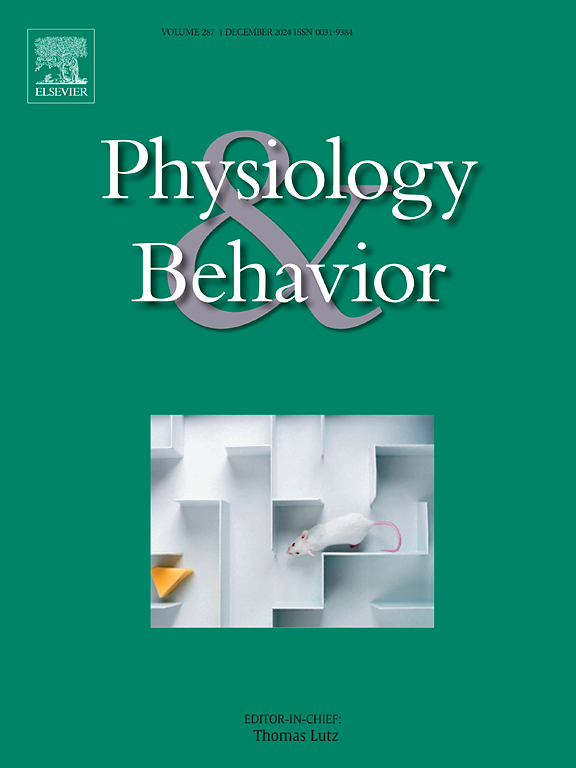Cytochrome-C-oxidase expression in the subiculum and anterior thalamic nuclei of rats increases following training in an extrapolation of serial stimulus patterns task
IF 2.4
3区 医学
Q2 BEHAVIORAL SCIENCES
引用次数: 0
Abstract
The brain continuously monitors the environment, comparing predictions based on memories of past regularities and action plans with current sensory information. The subiculum and the anteroventral thalamus have been proposed to play critical roles in this Generator of Predictions System (GPS). This study evaluated the hypothesis that cytochrome C oxidase (COX) expression changes in the subiculum and anterior thalamic nuclei of subjects exposed to training and testing in an extrapolation of serial stimulus pattern task that stimulates the generation of predictions. Shortly, male Wistar rats were trained to run through a straight alleyway to receive variable amounts of sunflower seeds. In each session (one session per day), the animals ran 4 successive trials, receiving different amounts of sunflower seeds in each trial. Subjects exposed to the monotonic pattern (M) received 14, 7, 3, and 1 sunflower seeds. Subjects exposed to the non-monotonic pattern (NM) received 14, 3, 7, and 1 sunflower seeds. The animals were trained for 20 sessions. In the 21st session, a fifth trial, never experienced before by the subjects, was added immediately after the fourth trial. An additional control group was not exposed to training in the task, allowing evaluation of COX expression in untrained subjects. Data revealed increased COX activity in the anteroventral thalamus, and in the ventral subiculum, all related to training in the NM, but not M, schedule of reward. Data also revealed reduced COX activity in the dorsal portion of the subiculum, restricted to subjects trained with the NM serial pattern. These figures suggest that the anteroventral thalamus and the ventral and dorsal subiculum are engaged in the acquisition of extrapolation of serial stimulus pattern tasks, thus opening novel avenues to studying neural brain circuits involved in generating predictions. One possibility, for instance, would be to evaluate the time course of these COX activations in association with training in the M and NM serial patterns.
在一系列刺激模式外推训练后,大鼠丘下核和丘脑前核细胞色素c氧化酶表达增加
大脑不断地监测环境,将基于过去规律和行动计划的记忆的预测与当前的感官信息进行比较。下骨和前腹侧丘脑已被提出在这种预测系统(GPS)中发挥关键作用。本研究评估了细胞色素C氧化酶(COX)表达在受试者暴露于一系列刺激模式任务外推刺激生成预测的训练和测试中的丘下核和丘脑前核变化的假设。简单地说,雄性Wistar大鼠经过训练,跑过一条笔直的小巷,以获得不同数量的葵花籽。在每一阶段(每天一阶段),动物连续进行4次试验,每次试验接受不同数量的葵花籽。暴露于单调模式(M)的受试者收到14、7、3和1颗葵花籽。暴露于非单调模式(NM)的受试者收到14、3、7和1颗葵花籽。这些动物接受了20次训练。在第21次试验中,在第4次试验之后立即增加了第5次试验,这是受试者从未经历过的。另一个对照组在任务中不接受训练,允许评估未经训练的受试者的COX表达。数据显示,丘脑腹侧前部和腹侧耻骨下的COX活性增加,这些都与NM奖励计划的训练有关,而与M奖励计划无关。数据还显示,在接受NM系列模式训练的受试者中,耻骨下背部分的COX活性降低。这些数据表明,前腹侧丘脑和腹侧和背侧的耻骨下参与了一系列刺激模式任务的外推获取,从而为研究涉及产生预测的神经脑回路开辟了新的途径。例如,一种可能性是评估与M和NM系列模式训练相关的这些COX激活的时间过程。
本文章由计算机程序翻译,如有差异,请以英文原文为准。
求助全文
约1分钟内获得全文
求助全文
来源期刊

Physiology & Behavior
医学-行为科学
CiteScore
5.70
自引率
3.40%
发文量
274
审稿时长
47 days
期刊介绍:
Physiology & Behavior is aimed at the causal physiological mechanisms of behavior and its modulation by environmental factors. The journal invites original reports in the broad area of behavioral and cognitive neuroscience, in which at least one variable is physiological and the primary emphasis and theoretical context are behavioral. The range of subjects includes behavioral neuroendocrinology, psychoneuroimmunology, learning and memory, ingestion, social behavior, and studies related to the mechanisms of psychopathology. Contemporary reviews and theoretical articles are welcomed and the Editors invite such proposals from interested authors.
 求助内容:
求助内容: 应助结果提醒方式:
应助结果提醒方式:


